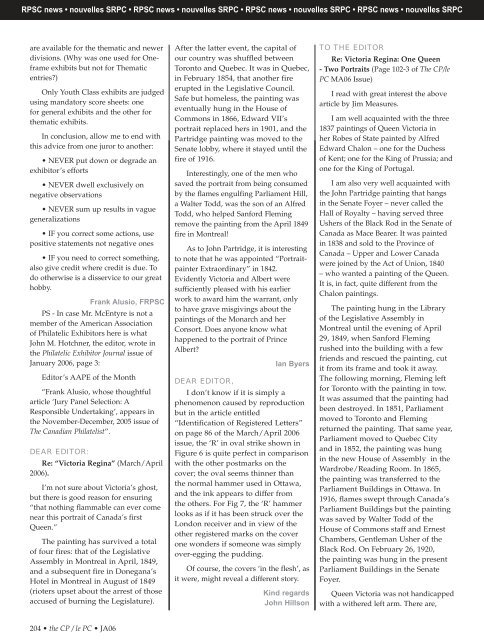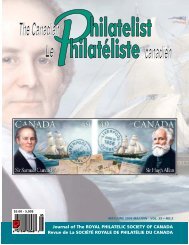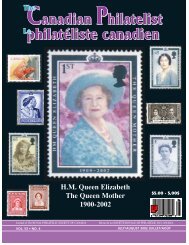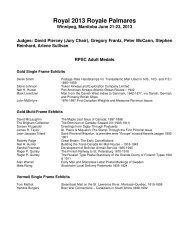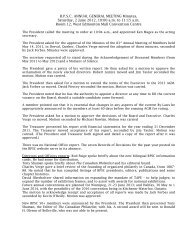Canadian Philatelist Philatéliste canadien - The Royal Philatelic ...
Canadian Philatelist Philatéliste canadien - The Royal Philatelic ...
Canadian Philatelist Philatéliste canadien - The Royal Philatelic ...
Create successful ePaper yourself
Turn your PDF publications into a flip-book with our unique Google optimized e-Paper software.
RPSC news • nouvelles SRPC • RPSC news • nouvelles SRPC • RPSC news • nouvelles SRPC • RPSC news • nouvelles SRPC<br />
are available for the thematic and newer<br />
divisions. (Why was one used for Oneframe<br />
exhibits but not for <strong>The</strong>matic<br />
entries?)<br />
Only Youth Class exhibits are judged<br />
using mandatory score sheets: one<br />
for general exhibits and the other for<br />
thematic exhibits.<br />
In conclusion, allow me to end with<br />
this advice from one juror to another:<br />
• NEVER put down or degrade an<br />
exhibitor’s efforts<br />
• NEVER dwell exclusively on<br />
negative observations<br />
• NEVER sum up results in vague<br />
generalizations<br />
• IF you correct some actions, use<br />
positive statements not negative ones<br />
• IF you need to correct something,<br />
also give credit where credit is due. To<br />
do otherwise is a disservice to our great<br />
hobby.<br />
Frank Alusio, FRPSC<br />
PS - In case Mr. McEntyre is not a<br />
member of the American Association<br />
of <strong>Philatelic</strong> Exhibitors here is what<br />
John M. Hotchner, the editor, wrote in<br />
the <strong>Philatelic</strong> Exhibitor Journal issue of<br />
January 2006, page 3:<br />
Editor’s AAPE of the Month<br />
“Frank Alusio, whose thoughtful<br />
article ‘Jury Panel Selection: A<br />
Responsible Undertaking’, appears in<br />
the November-December, 2005 issue of<br />
<strong>The</strong> <strong>Canadian</strong> <strong>Philatelist</strong>”.<br />
DEAR EDITOR:<br />
Re: “Victoria Regina” (March/April<br />
2006).<br />
I’m not sure about Victoria’s ghost,<br />
but there is good reason for ensuring<br />
“that nothing flammable can ever come<br />
near this portrait of Canada’s first<br />
Queen.”<br />
<strong>The</strong> painting has survived a total<br />
of four fires: that of the Legislative<br />
Assembly in Montreal in April, 1849,<br />
and a subsequent fire in Donegana’s<br />
Hotel in Montreal in August of 1849<br />
(rioters upset about the arrest of those<br />
accused of burning the Legislature).<br />
After the latter event, the capital of<br />
our country was shuffled between<br />
Toronto and Quebec. It was in Quebec,<br />
in February 1854, that another fire<br />
erupted in the Legislative Council.<br />
Safe but homeless, the painting was<br />
eventually hung in the House of<br />
Commons in 1866, Edward VII’s<br />
portrait replaced hers in 1901, and the<br />
Partridge painting was moved to the<br />
Senate lobby, where it stayed until the<br />
fire of 1916.<br />
Interestingly, one of the men who<br />
saved the portrait from being consumed<br />
by the flames engulfing Parliament Hill,<br />
a Walter Todd, was the son of an Alfred<br />
Todd, who helped Sanford Fleming<br />
remove the painting from the April 1849<br />
fire in Montreal!<br />
As to John Partridge, it is interesting<br />
to note that he was appointed “Portraitpainter<br />
Extraordinary” in 1842.<br />
Evidently Victoria and Albert were<br />
sufficiently pleased with his earlier<br />
work to award him the warrant, only<br />
to have grave misgivings about the<br />
paintings of the Monarch and her<br />
Consort. Does anyone know what<br />
happened to the portrait of Prince<br />
Albert?<br />
Ian Byers<br />
DEAR EDITOR,<br />
I don’t know if it is simply a<br />
phenomenon caused by reproduction<br />
but in the article entitled<br />
“Identification of Registered Letters”<br />
on page 86 of the March/April 2006<br />
issue, the ‘R’ in oval strike shown in<br />
Figure 6 is quite perfect in comparison<br />
with the other postmarks on the<br />
cover; the oval seems thinner than<br />
the normal hammer used in Ottawa,<br />
and the ink appears to differ from<br />
the others. For Fig 7, the ‘R’ hammer<br />
looks as if it has been struck over the<br />
London receiver and in view of the<br />
other registered marks on the cover<br />
one wonders if someone was simply<br />
over-egging the pudding.<br />
Of course, the covers ‘in the flesh’, as<br />
it were, might reveal a different story.<br />
Kind regards<br />
John Hillson<br />
TO THE EDITOR<br />
Re: Victoria Regina: One Queen<br />
- Two Portraits (Page 102-3 of <strong>The</strong> CP/le<br />
PC MA06 Issue)<br />
I read with great interest the above<br />
article by Jim Measures.<br />
I am well acquainted with the three<br />
1837 paintings of Queen Victoria in<br />
her Robes of State painted by Alfred<br />
Edward Chalon – one for the Duchess<br />
of Kent; one for the King of Prussia; and<br />
one for the King of Portugal.<br />
I am also very well acquainted with<br />
the John Partridge painting that hangs<br />
in the Senate Foyer – never called the<br />
Hall of <strong>Royal</strong>ty – having served three<br />
Ushers of the Black Rod in the Senate of<br />
Canada as Mace Bearer. It was painted<br />
in 1838 and sold to the Province of<br />
Canada – Upper and Lower Canada<br />
were joined by the Act of Union, 1840<br />
– who wanted a painting of the Queen.<br />
It is, in fact, quite different from the<br />
Chalon paintings.<br />
<strong>The</strong> painting hung in the Library<br />
of the Legislative Assembly in<br />
Montreal until the evening of April<br />
29, 1849, when Sanford Fleming<br />
rushed into the building with a few<br />
friends and rescued the painting, cut<br />
it from its frame and took it away.<br />
<strong>The</strong> following morning, Fleming left<br />
for Toronto with the painting in tow.<br />
It was assumed that the painting had<br />
been destroyed. In 1851, Parliament<br />
moved to Toronto and Fleming<br />
returned the painting. That same year,<br />
Parliament moved to Quebec City<br />
and in 1852, the painting was hung<br />
in the new House of Assembly in the<br />
Wardrobe/Reading Room. In 1865,<br />
the painting was transferred to the<br />
Parliament Buildings in Ottawa. In<br />
1916, flames swept through Canada’s<br />
Parliament Buildings but the painting<br />
was saved by Walter Todd of the<br />
House of Commons staff and Ernest<br />
Chambers, Gentleman Usher of the<br />
Black Rod. On February 26, 1920,<br />
the painting was hung in the present<br />
Parliament Buildings in the Senate<br />
Foyer.<br />
Queen Victoria was not handicapped<br />
with a withered left arm. <strong>The</strong>re are,<br />
204 • the CP / le PC • JA06


